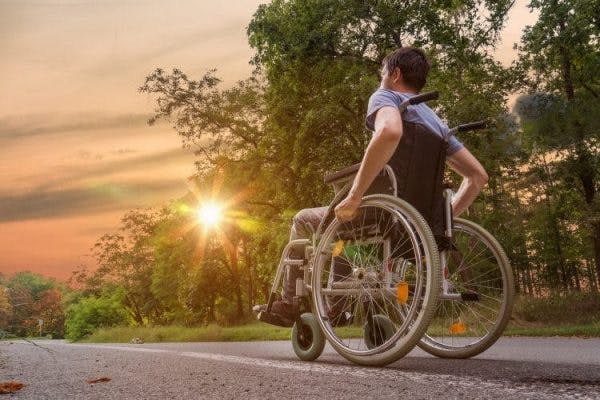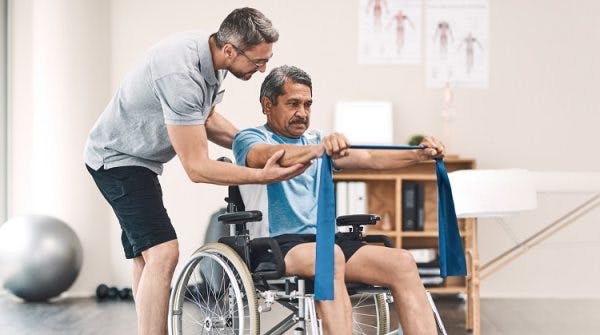Wondering if there’s a link between spinal cord injury and low blood pressure? In general, individuals with spinal cord injury are more susceptible to low blood pressure, especially in the early stages of recovery. Additionally, orthostatic hypotension is a condition many people experience after spinal cord injury.
It’s characterized by a drop in blood pressure (and associated dizziness/lightheadedness) when you change positions quickly, usually when trying to sit or stand up after laying down for long periods.
This article will explain how spinal cord injury can cause low blood pressure and what you can do to manage it.
How Spinal Cord Injury Causes Low Blood Pressure
A spinal cord injury interferes with communication between your brain and body. As a result, many of your major body functions may not work properly.
One of the main roles of the autonomic nervous system is to control involuntary functions like blood pressure and heart rate.
A spinal cord injury can disrupt the reflexes that make blood vessels constrict and relax. When blood vessels relax too much, there isn’t enough force to keep blood flowing efficiently, which causes low blood pressure.
Consequently, blood will start to pool in your arms and legs, reducing the total amount of blood circulating back to your heart.
The less blood your heart receives, the less blood can be pumped back to the body.
Orthostatic Hypotension and Spinal Cord Injury

Orthostatic hypotension is a condition characterized by low blood pressure after sitting or standing up too quickly.
Specifically, it occurs when systolic blood pressure (blood pressure when your heart is contracting) drops at least 20mmHg or diastolic blood pressure (blood pressure in between heartbeats) drops 10mmHg within 3 minutes of getting up.
Although anyone can get orthostatic hypotension, it is significantly more prevalent amongst cervical and high-thoracic spinal cord injury patients.
Additionally, it’s more common in the first couple of weeks following a spinal cord injury than later.
Upon getting up, individuals with orthostatic hypotension often experience:
- Lightheadedness
- Dizziness
- Impaired vision
- Fainting
- Muscle weakness
- Temporary loss of consciousness
- Shortness of breath
These symptoms are all characteristic of reduced blood flow to the brain.
The Best Ways to Manage Low Blood Pressure after Spinal Cord Injury

Treatment for low blood pressure after spinal cord injury focuses on increasing circulation and reducing the pooling of blood in the arms and legs.
The best ways to manage orthostatic hypotension and increase your blood pressure after spinal cord injury include:
1. Taking your time getting up
If you get up and suddenly start to feel disoriented, sit or lay down again until the dizziness goes away. You likely sat or stood up too fast.
The easiest way to avoid dizziness caused by low blood pressure after spinal cord injury is to take your time getting up.
Additionally, make sure that you’re holding onto a steady surface to avoid falling.
2. Staying hydrated
Another effective way to prevent drops in blood pressure after spinal cord injury is to drink enough water.
Dehydration can lower fluid volume in the body and result in unstable blood pressure.
This study found that drinking water can cause your blood vessels to constrict and help increase blood pressure.
3. Increasing sodium intake
Increasing your sodium intake will help elevate blood pressure.
However, consuming too much sodium can be harmful (even for those with low blood pressure) so try to find a good balance.
Some ideal snacks to help combat low blood pressure include salted nuts, cheeses, and olives.
4. Taking medications
Spinal cord injury patients might also find it helpful to take medications to increase their blood pressure.
Doctors may prescribe medications called vasopressors that cause your blood vessels to constrict and promote circulation.
Keep in mind that medications only provide temporary relief and may not be ideal for long-term use.
5. Exercising regularly
Regular exercise is essential for promoting efficient blood flow.
Due to paralysis, many spinal cord injury patients tend to not move enough to counteract blood pooling.
Exercise doesn’t have to be intense to be effective. Any sort of movement will help improve circulation, so try to perform some movement every couple of hours.
Especially before standing up, people with orthostatic hypotension may benefit from performing mild sitting exercises to stimulate blood flow.
Spinal Cord Injury and Low Blood Pressure: Summary
Spinal cord injuries often affect involuntary processes like blood pressure regulation.
When the autonomic nervous system isn’t receiving signals from the brain to regulate the tone of your blood vessels, they remain loose. Ultimately, this results in low blood pressure and blood pooling.
Generally, low blood pressure after spinal cord injury can be effectively managed through a few simple lifestyle adjustments like getting up slowly and staying hydrated.
Hopefully, this article helped you better understand the relationship between spinal cord injury and low blood pressure. If feelings of disorientation persist, seek medical attention. Good luck!











